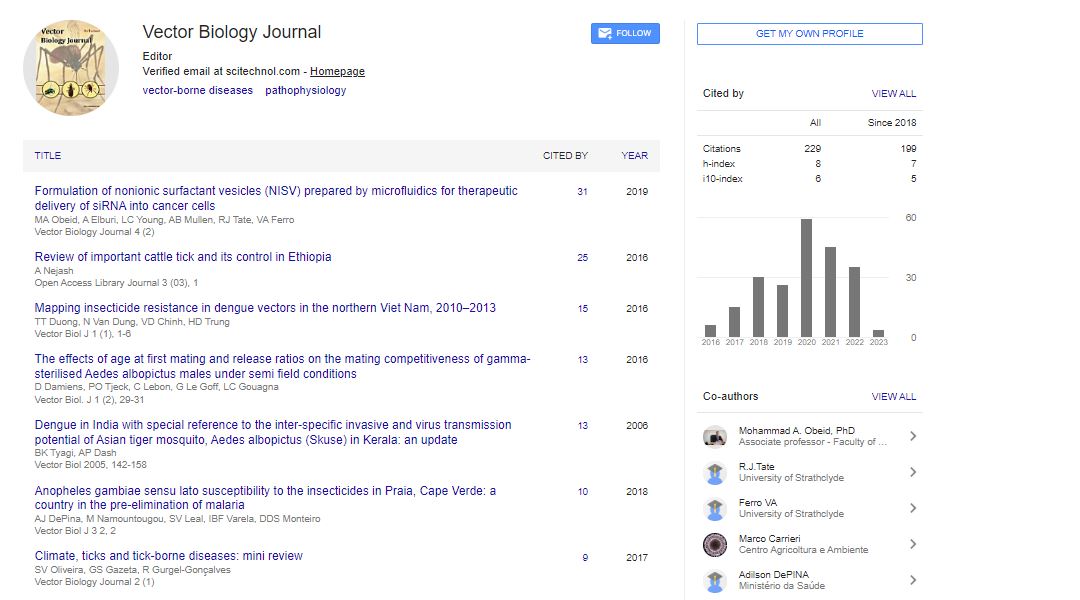Commentary, Vector Biol J Vol: 8 Issue: 4
Vectorial Capacity: Fundamental Concepts and Implications in Disease Transmission
Qiang Chen*
1Department of Biological Sciences, Southwest Jiaotong University, Chengdu, China
*Corresponding Author: Qiang Chen,
Department of Biological Sciences,
Southwest Jiaotong University, Chengdu, China
E-mail: chen.qia@gmail.com
Received date: 21 November, 2023, Manuscript No. VBJ-24-127982;
Editor assigned date: 23 November, 2023, PreQC No. VBJ-24-127982 (PQ);
Reviewed date: 07 December, 2023, QC No. VBJ-24-127982;
Revised date: 15 December, 2023, Manuscript No. VBJ-24-127982 (R);
Published date: 22 December, 2023, DOI: 10.4172/2473-4810.1000277.
Citation: Chen Q (2023) Vectorial Capacity: Fundamental Concepts and Implications in Disease Transmission. Vector Biol J 8:4.
Description
Vectorial capacity is a fundamental concept in epidemiology and public health, playing an important role in understanding the transmission dynamics of vector-borne diseases. It is a measure of the potential of vector organisms to transmit a particular pathogen to a susceptible host population. By quantifying the vector's ability to acquire, maintain, and transmit the pathogen, vectorial capacity provides valuable insights into the risk and spread of infectious diseases.
Vectorial capacity is determined by various factors intrinsic to both the vector and the pathogen it transmits. These factors include the Vector's destructive rate, vector competence (its ability to become infected and transmit the pathogen), the vector's longevity, and the host's destructive rate. Additionally, environmental factors such as temperature, humidity, and habitat suitability plays an essential roles in shaping vectorial capacity by influencing vector behavior, reproduction, and pathogen development within the vector.
One of the primary components of vectorial capacity is the vector's destructive rate, which refers to the frequency at which the vectors depend on machines. The higher destructive rate, greater the potential for pathogen transmission, as each bite presents an opportunity for the pathogen to be transmitted to a susceptible host. Vector competence, on the other hand, depends on the vector's ability to become infected with the pathogen, sustain its replication, and transmit it to another host during subsequent feedings. Vector competence varies among vector species and can be influenced by genetic factors, environmental conditions, and the presence of other microorganisms within the vector.
The durability of the vector is another significant component of vectorial capacity. Persistent vectors have more opportunities to acquire and transmit pathogens over their lifespan, increasing the overall risk of disease transmission within a population. Furthermore, environmental factors such as temperature can directly impact vector longevity, with higher temperatures frequently accelerating metabolic rates and shortening the lifespan of vectors, thereby influencing their vectorial capacity.
Vectorial capacity has significant implications for public health, especially in regions where vector-borne diseases provide significant threats to human populations. By understanding the factors that influence vectorial capacity, public health professionals can develop more effective methods for disease surveillance, vector control, and community education. For example, in areas where mosquito-borne diseases such as malaria and dengue fever are endemic, interventions aimed at reducing mosquito populations through insecticide-treated bed nets, indoor residual spraying, and environmental management can help to reduce the burden of disease and improve public health outcomes.
Furthermore, advances in technology and computational modeling have enabled researchers to improve and expand the understanding of vectorial capacity, allowing for more accurate predictions of disease transmission dynamics under different conditions. By incorporating real-time data on vector populations, pathogen prevalence, and environmental conditions, researchers can develop predictive models that inform proactive measures to prevent outbreaks and mitigate the spread of vector-borne diseases.
By quantifying the potential for disease transmission within a population, vectorial capacity helps to guide the development of targeted interventions aimed at reducing the burden of vector-borne diseases on human populations. As the analyzing of vector biology, pathogen dynamics, and environmental factors continues to evolve the ability to effectively control and prevent vector-borne diseases, eventually improving public health outcomes around the world.
 Spanish
Spanish  Chinese
Chinese  Russian
Russian  German
German  French
French  Japanese
Japanese  Portuguese
Portuguese  Hindi
Hindi 